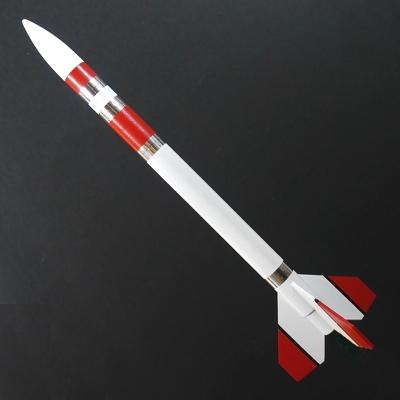HARA had scheduled an afternoon Halloween launch today at Pegasus field, but the threat of impending rain moved the launch time up from 1 PM to 10 AM. A good thing too, 'cause this afternoon has sucked in a weather sense. Duane and I arrived promptly at 10 and helped Chuck, Woody, and Art set up the range - a rail, Woody's tower, a mid power pad, and a single LPR rack. Everything was ready to go in just a few minutes, but we discovered problems with both HARA controllers when we tried to launch the first rocket. After dinking around for a few minutes with test lights and multimeters, it was decided the batteries were low on juice, which forced us to use Duane's hand held controller for the launch. It was switched from pad to pad - not very ideal, but it got the job done.
Some friends of Woody's also showed up with their kids, who were very excited to recover the rockets. This was fine with me, as I have been not feeling my best this week - thanks to these young folk, I did not have to chase after a single rocket. I know... It ought to be considered cheating and beneath a true rocketeer, but being tired, old, and fat should occasionally allow one a little slack. The recovery team was very fast and efficient; all rockets were returned undamaged, and I was most appreciative at not having to schlep my ancient rear across the field.
Duane's Death Star was first off the pad, riding a C6 motor in a long arc to the southeast. It did its usual break apart into streamered fragments upon ejection, which elicited oohs and aahs from the kiddos. My Target bowl saucer was next on a C6-0, followed by Woody's 29 mm scratch built on a composite D. It truly got up and left - burst mode caught only a single frame of it in the tower, and it was gone in the blink of an eye to us human watchers. I don't know how Woody managed to keep track of the rocket, but he did, and was able to direct the recovery crew to its landing spot.
 |  |
Duane's Death Star lifts off for Alderaan (Click to
enlarge). | My Target saucer on a C6-0 (Click to enlarge). |
Normally most creative fall rocket kudo goes to Chuck and his flying corn rockets, but this year Art Woodling gave him a run for his money by creating a "pumpkinik" - an orange hobby store craft pumpkin perched on top of 4 long orange dowels. It had two stable flights, albeit with a tendency to fly nearly horizontal after motor burnout. Chuck did fly a corn rocket - a plastic corncob perched on top of a long green body tube with leaf like fins; however, the F motor may have been a bit too much, as the rocket lost a couple of fins on the way up. The parachute deployed, but the motor casing was kicked from the rear and still lies somewhere on the field. Not to worry - I am confident that with all of the TARC activity at Pegasus, it will be found fairly soon.
 |  |
Art's "Pumpkinik" rises on a plume of fire (Click to
enlarge). | The F motor in Chuck's corn rocket ignites (Click to
enlarge). |
One of Woody's friends flew a nekkid payload model on a C motor, followed by Vince's venerable Big Bertha. I am always impressed by the serene and stately flights produced by the Bertha; it is truly a classic design. Vince also had good luck in the flight of his skull-topped "Death's Head", which surprises me with nice straight flights despite its ungainly looks. However, his luck ran out with a reflight of his Rocketarium Mega Vortico, which he put back together after it was rekitted by an E motor CATO a couple of months back. This time he chose to fly with an ancient Estes E15, a now discontinued motor notorious for its failure rate. The motor lived up to its reputation, erupting into a spectacular fireball just above the pad. The failure ripped the motor casing in half and blew the Mega Vortico into many small pieces. I had great sympathy for Vince as he picked up the fragments from the field, knowing that there was no way he could rebuild it this time.
 |  |
Vince's trusty Bertha turns in yet another flight (Click
to enlarge). | The recovery crew in action (Click to enlarge). |
 |  |
| Vince's "Death's Head" gets going (Click to enlarge). | A Woody rocket clears the rod (Click to enlarge). |
I had brought 7 Halloween-themed rockets to the field. The Target candy bowl was followed by my Estes Zoom Broom clone on an A10-3T motor - old Witch Hazel was happy to spend some time in the air after a year of resting on the shelf. The Goony Ghost jumped off the pad after Chuck's corn rocket flew, the B6-4 powering it to about 400 feet. A B6-4 was also the motor of choice for the "Ecto 1", a Ghost Buster-themed Red Max; it flew like an arrow into the overcast skies, and landed softly on a ripstop nylon chute. My Quasar One Spooktacular blasted off the rod on a C6-3, immediately followed by a clone of the Estes "The Bat", which flew on an A8-3. My final flight of the day was the newly-built Goblin, which performed spectacularly on a C11-5 (I don't want to think about flying it on a D12).
 |
The F motor in Duane's "Beast" gets it moving (Photo by Woody -
Click to enlarge). |




































